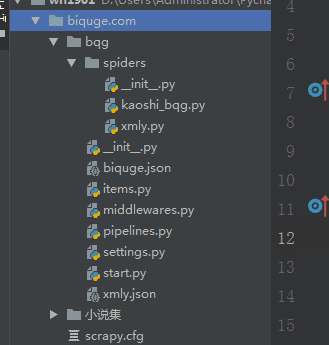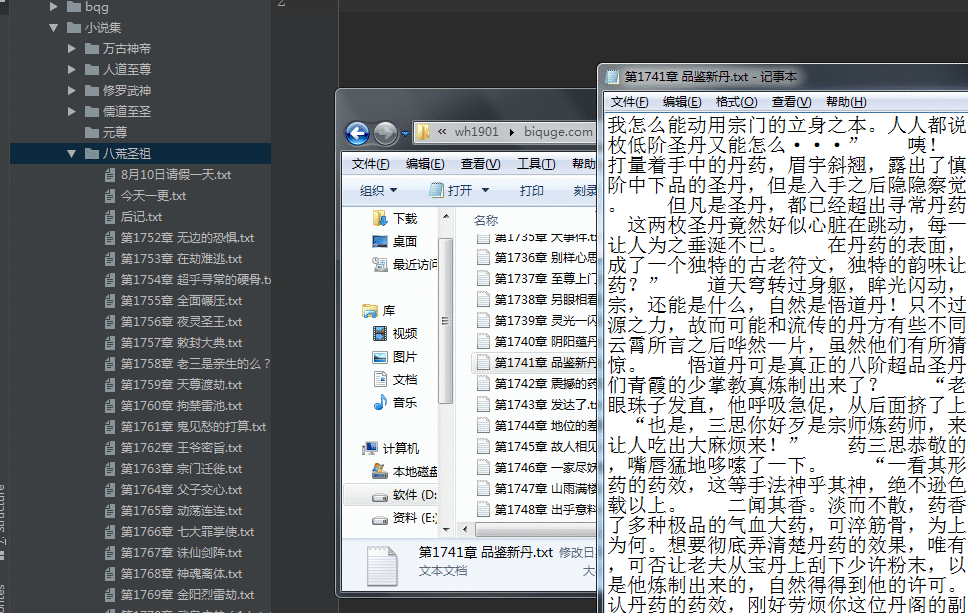python scrapy爬虫代码及填坑
涉及到详情页爬取
目录结构:

kaoshi_bqg.py
import scrapy
from scrapy.spiders import Rule
from scrapy.linkextractors import LinkExtractor
from ..items import BookBQGItem
class KaoshiBqgSpider(scrapy.Spider):
name = 'kaoshi_bqg'
allowed_domains = ['biquge5200.cc']
start_urls = ['https://www.biquge5200.cc/xuanhuanxiaoshuo/']
rules = (
# 编写匹配文章列表的规则
Rule(LinkExtractor(allow=r'https://www.biquge5200.cc/xuanhuanxiaoshuo/'), follow=True),
# 匹配文章详情
Rule(LinkExtractor(allow=r'.+/[0-9]{1-3}_[0-9]{2-6}/'), callback='parse_item', follow=False),
)
# 小书书名
def parse(self, response):
a_list = response.xpath('//*[@id="newscontent"]/div[1]/ul//li//span[1]/a')
for li in a_list:
name = li.xpath(".//text()").get()
detail_url = li.xpath(".//@href").get()
yield scrapy.Request(url=detail_url, callback=self.parse_book, meta={'info': name})
# 单本书所有的章节名
def parse_book(self, response):
name = response.meta.get('info')
list_a = response.xpath('//*[@id="list"]/dl/dd[position()>20]//a')
for li in list_a:
chapter = li.xpath(".//text()").get()
url = li.xpath(".//@href").get()
yield scrapy.Request(url=url, callback=self.parse_content, meta={'info': (name, chapter)})
# 每章节内容
def parse_content(self, response):
name, chapter = response.meta.get('info')
content = response.xpath('//*[@id="content"]//p/text()').getall()
item = BookBQGItem(name=name, chapter=chapter, content=content)
yield item
xmly.py
# -*- coding: utf-8 -*-
import scrapy
from ..items import BookXMLYItem, BookChapterItem
class XmlySpider(scrapy.Spider):
name = 'xmly'
allowed_domains = ['ximalaya.com']
start_urls = ['https://www.ximalaya.com/youshengshu/wenxue/']
def parse(self, response):
div_details = response.xpath('//*[@id="root"]/main/section/div/div/div[3]/div[1]/div/div[2]/ul/li/div')
# details = div_details[::3]
for details in div_details:
book_id = details.xpath('./div/a/@href').get().split('/')[-2]
book_name = details.xpath('./a[1]/@title').get()
book_author = details.xpath('./a[2]/text()').get() # 作者
book_url = details.xpath('./div/a/@href').get()
url = 'https://www.ximalaya.com' + book_url
# print(book_id, book_name, book_author, url)
item = BookXMLYItem(book_id=book_id, book_name=book_name, book_author=book_author, book_url=url)
yield item
yield scrapy.Request(url=url, callback=self.parse_details, meta={'info': book_id})
def parse_details(self, response):
book_id = response.meta.get('info')
div_details = response.xpath('//*[@id="anchor_sound_list"]/div[2]/ul/li/div[2]')
for details in div_details:
chapter_id = details.xpath('./a/@href').get().split('/')[-1]
chapter_name = details.xpath('./a/text()').get()
chapter_url = details.xpath('./a/@href').get()
url = 'https://www.ximalaya.com' + chapter_url
item = BookChapterItem(book_id=book_id, chapter_id=chapter_id, chapter_name=chapter_name, chapter_url=url)
yield item
item.py
import scrapy # 笔趣阁字段 class BookBQGItem(scrapy.Item): name = scrapy.Field() chapter = scrapy.Field() content = scrapy.Field() # 喜马拉雅 字段 class BookXMLYItem(scrapy.Item): book_name = scrapy.Field() book_id = scrapy.Field() book_url = scrapy.Field() book_author = scrapy.Field() # 喜马拉雅详情字段 class BookChapterItem(scrapy.Item): book_id = scrapy.Field() chapter_id = scrapy.Field() chapter_name = scrapy.Field() chapter_url = scrapy.Field()
pipelines.py
from scrapy.exporters import JsonLinesItemExporter
import os
class BqgPipeline(object):
def process_item(self, item, spider):
xs = '小说集'
name = item['name']
xs_path = os.path.join(os.path.dirname(os.path.dirname(__file__)), xs)
fiction_path = os.path.join(xs_path, name)
# print(os.path.dirname(__file__)) D:/Users/Administrator/PycharmProjects/wh1901/biquge.com
# print(os.path.dirname(os.path.dirname(__file__))) D:/Users/Administrator/PycharmProjects/wh1901
if not os.path.exists(xs_path): # 如果目录不存在
os.mkdir(xs_path)
if not os.path.exists(fiction_path):
os.mkdir(fiction_path) # 创建目录
chapter = item['chapter']
content = item['content']
file_path = os.path.join(fiction_path, chapter) + '.txt' # 在 该目录下面创建 xx .txt 文件
with open(file_path, 'w', encoding='utf-8') as fp:
fp.write(content + '\n')
print('保存成功')
# class XmlyPipeline(object):
# def __init__(self):
# self.fp = open("xmly.json", 'wb')
# # JsonLinesItemExporter 调度器
# self.exporter = JsonLinesItemExporter(self.fp, ensure_ascii=False)
#
# def process_item(self, item, spider):
# self.exporter.export_item(item)
# return item
#
# def close_item(self):
# self.fp.close()
# print("爬虫结束")
starts.py
from scrapy import cmdline
cmdline.execute("scrapy crawl kaoshi_bqg".split())
# cmdline.execute("scrapy crawl xmly".split())
然后是爬取到的数据
小说

xmly.json

记录一下爬取过程中遇到的一点点问题:
在爬取详情页的的时候, 刚开始不知道怎么获取详情页的 url 以及 上一个页面拿到的字段

- 也就是 yield 返回 请求详情页 里面的参数没有很好地理解
- meta:从其他请求传过来的meta属性,可以用来保持多个请求之间的数据连接。
- url:这个request对象发送请求的url。
- callback:在下载器下载完相应的数据后执行的回调函数。
以上就是本文的全部内容,希望对大家的学习有所帮助,也希望大家多多支持【听图阁-专注于Python设计】。